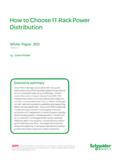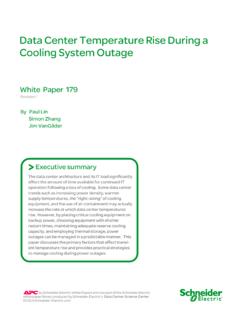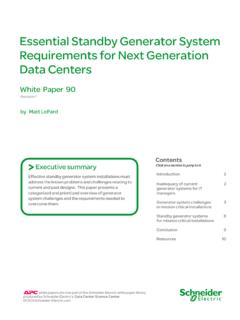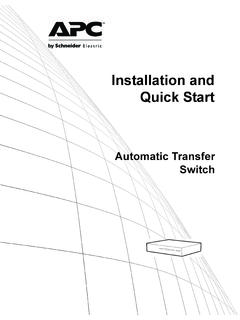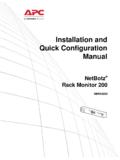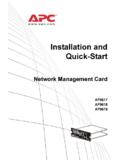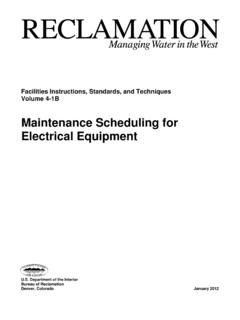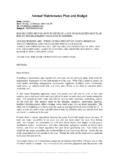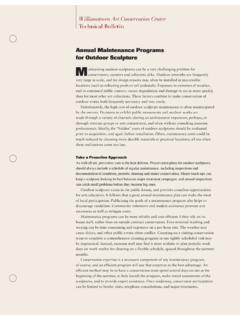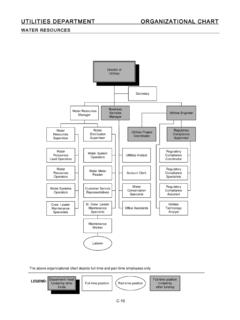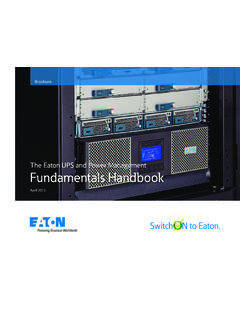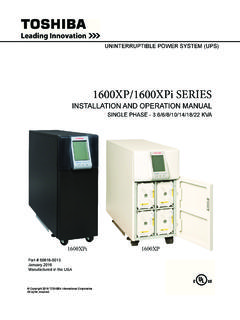Transcription of Preventive Maintenance Strategy for Data Centers …
1 Preventive Maintenance Strategy for data Centers Revision 1 by Thierry Bayle Introduction 2PM outcomes 3 Evolution of PM 3 Evidence of PM progress4 Why physical infrastructure components fail 6 Recommended practices7PM options 11 Conclusion 14 Resources 15 Click on a section to jump to it Contents White Paper 124 In the broadening data center cost-saving and energy efficiency discussion, data center physical infrastruc-ture Preventive Maintenance (PM) is sometimes neglected as an important tool for controlling TCO and downtime. PM is performed specifically to prevent faults from occurring. IT and facilities managers can improve systems uptime through a better understand-ing of PM best practices. This white paper describes the types of PM services that can help safeguard the uptime of data Centers and IT equipment rooms.
2 Various PM methodologies and approaches are dis-cussed. Recommended practices are suggested. Executive summary> white papers are now part of the Schneider Electric white paper libraryproduced by Schneider Electric s data center Science center Preventive Maintenance Strategy for data Centers Schneider Electric data center Science center White Paper 124 Rev 1 2 PPreventive reventive MMaintenanceaintenanceData centerHands-onNon-invasiveScheduledCondi tion-based This paper highlights data center power and cooling systems Preventive Maintenance (PM) best practices. Hands-on PM methods ( , component replacement, recalibration) and non-invasive PM techniques ( , thermal scanning, software monitoring) are reviewed. The industry trend towards more holistic and less component-based PM is also discussed. The term Preventive Maintenance (also known as preventative Maintenance ) implies the systematic inspection and detection of potential failures before they occur.
3 PM is a broad term and involves varying approaches to problem avoidance and prevention depending upon the criticality of the data center . Condition-based Maintenance , for example, is a type of PM that estimates and projects equipment condition over time, utilizing probability formulas to assess downtime risks. PM should not be confused with unplanned Maintenance , which is a response to an unanticipated problem or emergency. Most of the time, PM includes the replacement of parts, the thermal scanning of breaker panels, component / system adjustments, cleaning of air or water filters, lubrication, or the updating of physical infrastructure firmware. At the basic level, PM can be deployed as a Strategy to improve the availability performance of a particular data center component. At a more advanced level, PM can be leveraged as the primary approach to ensuring the availability of the entire data center power train (generators, transfer switches, transformers, breakers and switches, PDUs, UPSs) and cooling train (CRACs, CRAHs, humidifiers, condensers, chillers).
4 A data center power and cooling systems Preventive Maintenance (PM) Strategy ensures that procedures for calendar-based scheduled Maintenance inspections are established and, if appropriate, that condition-based Maintenance practices are considered. The PM Strategy should provide protection against downtime risk and should avoid the problem of postponed or forgotten inspection and Maintenance . The Maintenance plan must also assure that fully trained and qualified Maintenance experts observe the physical infrastructure equipment ( , look for changes in equipment appearance and performance and also listen for changes in the sounds produced by the equipment) and perform the necessary work. Introduction Figure 1 Today s PM landscape Preventive Maintenance Strategy for data Centers Schneider Electric data center Science center White Paper 124 Rev 1 3 One of four results can be expected during a PM visit: A potential issue is identified and immediate actions are taken to prevent a future fail-ure.
5 This is the most prevalent outcome of a PM visit. A new, active issue is identified and an appropriate repair is scheduled. Such a visit should be precisely documented so that both service provider and data center owner can compare the most current incident with past PMs and perform trend analysis. No issue is identified during the visit and no downtime occurs through to the next PM visit. The equipment is manufacturer approved and certified to function within operating guidelines. A defect is identified and an attempted repair of this defect results in unanticipated downtime during the PM window or shortly thereafter ( , a new problem is introduced). The risk of a negative outcome increases dramatically when an under-qualified person is performing the Maintenance . Methods for mitigation of PM-related downtime risks will be discussed later in this paper. In the data Centers of the 1960s, data center equipment components were recognized as common building support systems and maintained as such.
6 At that time, the data center was ancillary to the core business and most critical business processing tasks were performed manually by people. On the data center owner side, the attitude was Why spend money on Maintenance ? Manufacturers were interested in the installation of equipment but the fix it business was not something they cared about. Over time, computers began performing numerous important business tasks. As more and more corporate data assets began to migrate to the data center , equipment breakage and associated downtime became a serious threat to business growth and profitability. Manufac-turers of data center IT equipment began to recognize that an active Maintenance program would maintain the operational quality of their products. Annual Maintenance contracts were introduced and many data center owners recognized the benefits of elevated service levels. As corporate data evolved into a critical asset for most companies, proper Maintenance of the IT equipment became a necessity for supporting the availability of key business applications.
7 The PM concept today represents an evolution from a reactive Maintenance mentality ( fix it, it s broken ) to a proactive approach ( check it and look for warning signs and fix it before it breaks ) in order to maximize 24x7x365 availability. Impact of changes in physical infrastructure architecture As with computer Maintenance , data center physical infrastructure ( power and cooling) equipment Maintenance has also evolved over time. In the 1980s the internal architecture of a UPS, for example, consisted of 100% separate components that were not, from a mainten-ance repair perspective, physically integrated with other key components within the device. These UPSs required routine Maintenance such as adjustment, torquing and cleaning in order to deliver the desired availability. A Maintenance person would be required to spend 6-8 hours per visit, per UPS, inspecting and adjusting the individual internal components. In the 1990 s the architecture of the UPS evolved (see Figure 2).
8 Physical infrastructure equipment began featuring both individually maintainable components and integrated, computerized (digital) components. During this time period, a typical UPS consisted of only PM outcomes Evolution of PM Preventive Maintenance Strategy for data Centers Schneider Electric data center Science center White Paper 124 Rev 1 4 50% manually maintainable parts with the remainder of the guts comprised of computerized components that did not require ongoing Maintenance . By the mid-1990 s the computerized components within the UPS began to communicate internal health status to operators in the form of output messages. Although PM visits were still required on a quarterly basis, the repairperson spent an average of 5 hours per visit per UPS. At present, the ratio of maintainable parts to computerized components has shifted further to 25% manually maintainable parts and 75% computerized parts (see Figure 2).
9 Today, most data center sites require one or two PM visits per year. However, more PM visits may be required if the physical infrastructure equipment resides in a hostile environment ( , high heat, dust, contaminants, vibration). The frequency of visits depends upon the physical environment and the business requirements of the data center owner. The system design of the component may also impact the frequency of PM visits. Often the number of visits is based upon the manufacturer s recommendation. Today s physical infrastructure is much more reliable and Maintenance -friendly than in the past. Manufacturers compete to design components that are as mistake-proof as possible. Examples of improved hardware design include the following: Computer room air conditioners (CRACS) with side and front access to internal compo-nents (in addition to traditional rear access) Variable frequency drives (VFDs) in cooling devices to control speed of internal cooling fans. VFDs eliminate the need to service moving belts (which are traditionally high- Maintenance items) Wrap-around bypass functionality in UPS that can eliminate IT downtime during PM 25%SeparateComponents10%SeparateComponen ts100%SeparateComponents50%SeparateCompo nents1980s1990sPresent(2007)2010andbeyon dMonthly visitQuarterly visitAnnual visitInternal redundancyTransition to whole power and cooling train PM50%Merged/ComputerizedComponents90%Mer ged/ComputerizedComponents75%Merged/Comp uterizedComponentsTraditional UPSC omputerized UPSF igure 2 Evolution of UPS design and associated PM Evidence of PM progress Preventive Maintenance Strategy for data Centers Schneider Electric data center Science center White Paper 124 Rev 1 5 In addition to hardware improvements, infrastructure design and architecture has evolved in ways that support the PM goals of easier planning, fewer visits, and greater safety.
10 For example: Redundant cooling or power designs that allow for concurrent Maintenance the critical IT load is protected even while Maintenance is being performed Proper design of crimp connections (which provide an electrical and mechanical con-nection) can reduce or eliminate the need for re-torquing , which, if performed in excess, can increase exposure to potential arc flash Recent attention to the dangers of arc flash are now influencing system design, in order to protect PM personnel from the risk of electrical injury during Maintenance Software design as a critical success factor The design of the physical infrastructure hardware is one way reduce PM cost and complexi-ty. Efficient physical infrastructure management software design is being vaulted to the forefront as the critical success factor for maintaining high availability. Best in class data Centers leverage physical infrastructure management software. Through self-diagnosis, infrastructure components can communicate usage hours, broadcast warnings when individual components are straying from normal operating temperatures, and can indicate when sensors are picking up abnormal readings.

